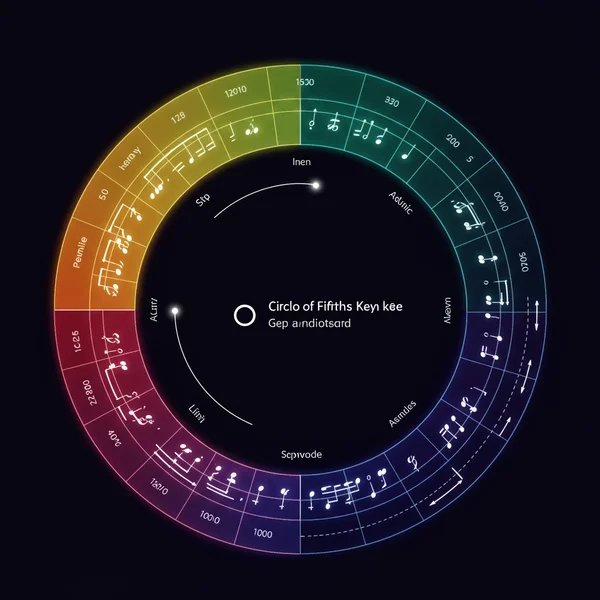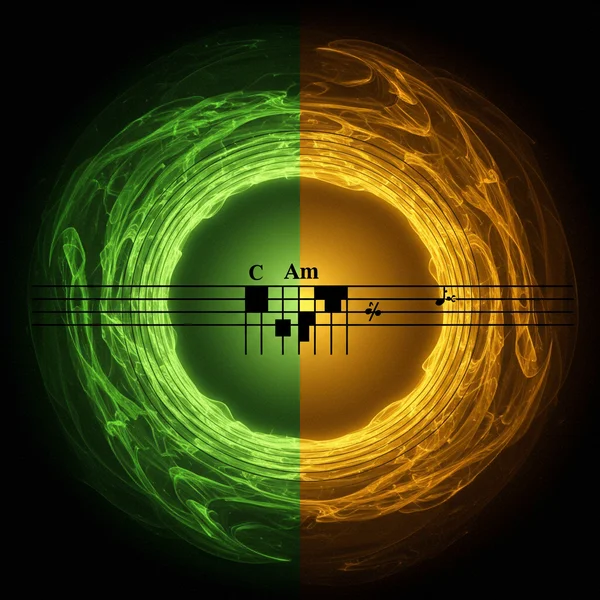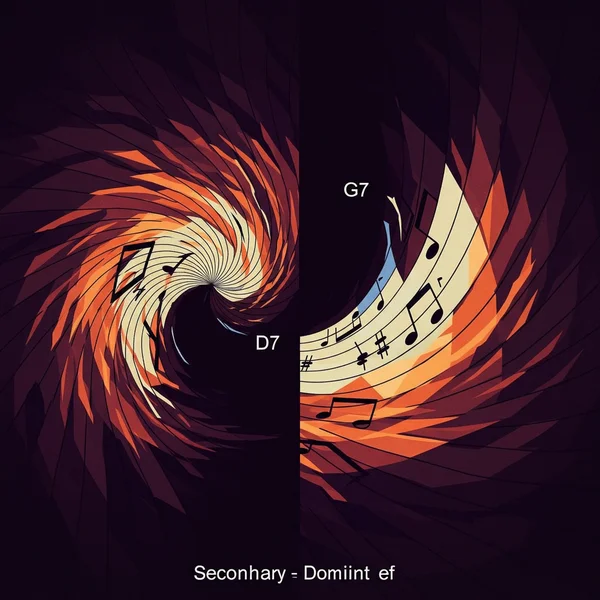Master Modulation: 3 Key Changes with the Circle of Fifths
Does your songwriting ever feel a little… static? You’ve crafted a great verse and a killer chorus, but the whole piece feels like it’s stuck in one place. If you're looking to add emotional depth, excitement, and a professional touch to your music, the answer lies in modulation—the art of changing keys. It might sound complex, but with the right map, it's a journey any composer can master. The best map for this harmonic adventure is the circle of fifths. So, how to use the circle of fifths to unlock dynamic harmony in your songs?
This guide will demystify key changes and give you three powerful techniques to create smooth, effective modulations. We’ll show you how our interactive music tool can transform this complex theory from a confusing chart into an intuitive, hands-on creative process. Get ready to take your listeners on an unforgettable harmonic journey.

Modulation vs. Transposition: Understanding the Key Difference
Before we dive into changing keys, it's crucial to understand a common point of confusion. Many musicians use the terms "modulation" and "transposition" interchangeably, but they describe two very different musical concepts. Grasping this distinction is the first step toward intentional and impactful songwriting.
What is Transposition? A Simple Shift in Pitch
Think of transposition as moving your entire song up or down in pitch. If you write a song in C Major and find it's too low for a singer, you might transpose it up to G Major. Every single note and chord is shifted by the same interval. The relationships between the chords (like the progression I-V-vi-IV) remain identical. It's the same song, just in a different register. It's a change of key, not a change within the song.
What is Modulation? A Journey to a New Tonal Center
Modulation, on the other hand, is a journey. It’s the process of changing the tonal center during a piece of music. You might start a song in C Major, but by the time you reach the second chorus, you’ve smoothly transitioned to the key of G Major. This isn't just a pitch shift; it's a fundamental change in the song's harmonic landscape. A successful modulation feels like a deliberate, emotional shift that adds narrative and dynamic energy to your composition.
The Circle of Fifths: Your Map for Seamless Key Changes
So, how do you navigate from one key to another without sounding clunky or random? This is where the Circle of Fifths becomes your most valuable songwriting companion. It's more than just a diagram of key signatures; it’s a visual map of harmonic relationships, showing you which keys are closely related and will therefore make for the smoothest transitions.
Visualizing Closely Related Keys
On the Circle of Fifths, keys that are neighbors are harmonically close. For example, C Major is positioned between F Major (one flat) and G Major (one sharp). This proximity means they share many of the same chords, making them perfect candidates for modulation. Moving one step clockwise (to the dominant key, like C to G) or one step counter-clockwise (to the subdominant key, like C to F) is the most common and natural-sounding modulation in all of music. The same principle applies to their relative minors, which are shown on the inner ring.

How Our Interactive Tool Elevates Your Modulation Practice
This is where theory truly meets practice! Forget static diagrams—imagine a tool where you can instantly explore these relationships, getting hands-on with harmony. Our free Circle of Fifths is designed for this exact purpose. Click on C Major, and you’ll instantly see its diatonic chords. Now, click on its neighbor, G Major. You can immediately compare the chord palettes of both keys and see which ones they have in common. This visual feedback makes finding pathways between keys intuitive and fast, empowering you to experiment with modulation confidently.
3 Powerful Techniques for Smooth Songwriting Modulation
Ready to get your hands dirty? Here are three proven techniques for modulation, from the subtle to the dramatic. For each one, we encourage you to open our online Circle of Fifths and follow along.
Technique 1: Pivot Chords – The Common Ground
The smoothest way to change key is by using a pivot chord—a chord that exists naturally in both the original key and the new key. It acts as a common ground, a harmonic doorway that allows the listener to walk from one tonal room to another without noticing the threshold.
How to Do It:
-
Identify Your Target Key: Using the Circle of Fifths, choose a closely related key. Let's say we're moving from C Major to its dominant, G Major.
-
Find the Pivot: Look for chords shared between C Major and G Major. Our interactive chart makes this easy. You'll see several common chords, including Am (the vi of C and the ii of G) and Em (the iii of C and the vi of G).
-
Use the Pivot: In your C Major progression, land on the Am chord. Instead of treating it as the vi of C, re-frame it as the ii of G. From there, you can proceed with a classic G Major progression, like ii-V-I (Am - D7 - G). The transition feels seamless because the Am chord acted as a perfect pivot.

Technique 2: Secondary Dominants – The V7 of the New Key
If you want to announce your key change with a bit more authority, the secondary dominant is your best friend. This technique involves using the dominant 7th chord of your target key to create powerful tension that "pulls" the listener into the new tonal center.
How to Do It:
-
Choose Your Target Key: Again, let's aim for G Major from our home base of C Major.
-
Find the Target's Dominant: The dominant (V) chord of G Major is D. The dominant 7th is D7.
-
Insert and Resolve: In your C Major progression, right before you want to land on G, insert the D7 chord. The D7 chord contains a C# and an F, two notes that are not in the key of C Major. This creates a compelling dissonance that your listener’s ear will want to resolve. Following the D7 with a G Major chord provides a deeply satisfying sense of arrival in the new key. Visualize this relationship by finding the V chord of any key instantly.

Technique 3: Direct Modulation – The Bold Leap
Sometimes, you don't want a smooth transition. You want a sudden, dramatic lift that grabs the listener's attention. This is a direct modulation, also known as a "truck driver's gear change" when it moves up by a step. It's a bold leap from one key to another with no connecting chords.
How to Do It:
- Establish Your First Key: Play a strong progression in your original key, coming to a clear final chord. For example, end a chorus in C Major with a strong C chord.
- Make the Jump: Simply start the next section (like a new verse or the final chorus) in a new key, often a half-step or whole-step higher (e.g., C# Major or D Major).
- Commit to the New Key: Once you've made the jump, firmly establish the new tonal center with a strong I-IV-V progression. This technique is all about energy and surprise. While our tool can't predict this leap, it’s invaluable for instantly understanding the new harmonic landscape you've just landed in. Check out the chords for your new key signature to continue writing with confidence.
Your Next Harmonic Adventure Awaits with the Circle of Fifths
Modulation is the key to unlocking a new level of emotional depth and sophistication in your music. By moving beyond a single key, you can create tension, release, surprise, and a sense of progression that will captivate your audience. It’s not an arcane secret of music theory; it’s a practical skill.
With the Circle of Fifths as your guide, you can visualize harmonic relationships and plan your modulations with purpose. The three techniques—Pivot Chords, Secondary Dominants, and Direct Modulation—provide a versatile toolkit for any songwriting scenario.
Don’t just read about it. The best way to learn is by doing. Go to CircleOfFifths.io and start exploring. Click between keys, compare their chords, and hear the relationships for yourself. Turn theory into sound and transform your static songs into dynamic journeys today.
Frequently Asked Questions About Music Modulation
Can the Circle of Fifths help me find chords for my key change?
Absolutely. This is one of its primary functions for composers. By showing you which keys are adjacent, it immediately points to the smoothest modulations. Our interactive tool takes it a step further by instantly displaying all the diatonic chords for any key you select, making it incredibly easy to find common "pivot" chords between your old and new keys.
What are common mistakes composers make when modulating?
A frequent mistake is modulating too abruptly to a distant key without proper setup, which can sound jarring or random to the listener. Another is modulating too often, which can make the music feel unstable and prevent a clear tonal center from being established. The key is to make modulations feel intentional and emotionally motivated.
How does modulation impact the emotional feel of a song?
Modulation is a powerful emotional tool. A modulation to a higher key, especially a direct one before a final chorus, can create a sense of uplift, excitement, and increased energy. Modulating to the dominant key (e.g., C to G) can feel bright and forward-moving, while modulating to the subdominant (e.g., C to F) can feel more relaxed or introspective.
Is modulation a form of transposing a song?
No, and this is a critical distinction. Transposing involves taking an entire piece of music and shifting every note up or down by the same interval—the song itself doesn't change, only its overall pitch. Modulation is a harmonic event within the song where the music moves from one tonal center to another, creating a dynamic shift in the composition itself.